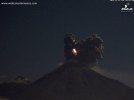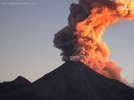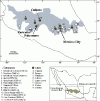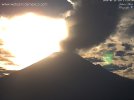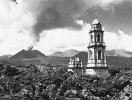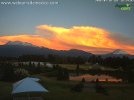Paricutín
Parícutin (or Volcán de Parícutin, also accented Paricutín) is a dormant scoria-cone volcano located in the Mexican state of Michoacán, near the city of Uruapan and about 322 km west of Mexico City.The volcano surged suddenly from the cornfield of local farmer Dionisio Pulido in 1943, attracting both popular and scientific attention. This eruption presented the first occasion for modern science to document the full life cycle of an eruption of this type. During the 9-year life span of Parícutin, scientists sketched and mapped it, took samples as well as thousands of photographs of this volcano. By 1952, the volcano left a 424 meter high cone and significantly damaged a 233 km2 area with the ejection of stone, ash and lava. Three people were killed, two towns were completely evacuated and buried by lava and three others were heavily affected. Hundreds of people had to be permanently relocated, with two new towns created to accommodate the migration of people. Although the area still remains highly active volcanically, Parícutin itself is quiet and has become a tourist attraction, with people climbing the volcano itself and visiting the hardened-lava covered ruins of the San Juan Parangaricutiro Church. Parícutin is one of the Seven Natural Wonders of the World as assigned by CNN.
The volcano lies on, and is a product of, the Trans-Mexican Volcanic Belt, which runs 900km west to east across central Mexico. It includes the Sierra Nevada mountain range, (a set of extinct volcanoes) as well as thousands of cinder cones and volcanic events. Volcanic activity here has created the Central Mexican Plateau, and rock deposits up to 1.8km deep.It has also created fertile soils and some of Mexico’s most productive farmland.[8]The volcanic activity here is a result of the subduction of the Rivera and Cocos plates along the Middle America Trench.[9] More specifically, the volcano is the youngest of the approximately 1,400 volcanic vents of the Michoacán-Guanajuato volcanic field, a 40,000km2 basalt plateau, filled with scoria cones, like Parícutin, along with small shield volcanoes, maars, tuff rings and lava domes.[10][9] Scoria cones are the most common type of volcano in Mexico, appearing suddenly, and building a cone-shaped mountain with steep slopes before going extinct, with Parícutin's immediate predecessor being Jorullo, also in Michoacán, which arose in 1759.[8][11]
Currently the crater of the volcano is about 200 meters across and it is possible to both climb the volcano and walk around the entire perimeter.[7] Although classified as extinct by scientists, it is still hot, and seeping rainwater reacts with this heat so that the cone still emits steam in various streams.[12][7][13] However, the forces that created the volcano are still active. In 1997 there was a vigorous swarm of 230 earthquakes with five above 3.9 in the Paricutin area due to tectonic movement.[9] There were some reports of rumbling in 1995 and of black steam and rumbling in 1998.[13] In the summer of 2006, there was another major volcanic earthquake swarm, with over 300 located near the volcano, indicating magma movement, but with no eruption at Paricutin or anywhere else.




